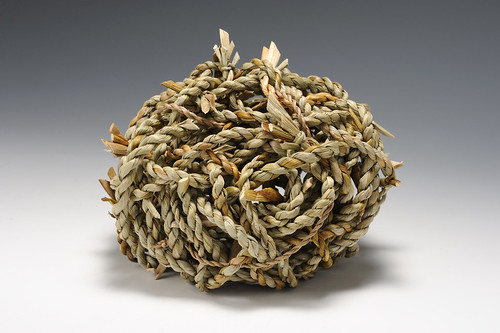Ideas come from the materials I choose to make use of. I accumulate diverse stuff from the many boxes and baskets in my workshop, laying them out on my workshop tables, feeling, looking, thinking, as I do it. It is an inward process, intense, important to the final result. It is that selection and handling that usually suggests the direction of the work. The techniques I choose follow the materials. Themed projects start with acceptance of some ideas and rejection of others, whittling them down to a starting point. These are interesting processes but need sustained time and continuity, difficult to achieve in a working life which is rich in variety.
Once decisions as to materials, technique, form, are taken, it is the small choices that must be made during work that intrigue and force me forward. That internal, eternal question ’What happens if….?’ turns the making process into an endless search for an object that will satisfy in its detail. That satisfaction must be mine, not that of observers, although I hope they feel it too.
I am a willow specialist, having learnt local, traditional work from apprenticed makers, enjoying the precision and neatness required. Widening contacts with overseas basketmakers, teaching in Europe and the USA, introduced me to wider fields of work. A Research Fellowship in Basketmaking gave me the freedom to explore these creative possibilities and generated other ways of making. The frequent daily walks though the enormous Embroidery studios at Manchester Metropolitan University, each student space with the usual plethora of drawings, samples, small explosions of creativity. It was so stimulating to a scientist trained to use more exact experimental methods for exploration of materials. It gave me leave to experiment simply for the sake of it. My techniques and materials now vary from the natural to the man-made but willow remains my core material.
This exploration of Bronze Age creativity has given me stimulus and opportunity. Visits to collections in Devizes and the National Museum of Denmark, marveling at the objects in the British Museum, looking in Dover Museum at their amazing boat bound with yew rope, has been fascinating. Holding a coiled pot, apparently unrefined, but with careful incised decoration extending to the underside, has made me think about those hands that shaped these objects, about their sources of inspiration, so rich and varied in their results.
The objects that appeal to me the most from the Bronze Age relate to those I already knew and found fascinating: the fish trap funnel form, the spiral decoration, the bags and nets and buried boxes full of small treasures. My own visits to special places result in beach findings, tickets, stones, sections of plants, which I keep together as reminders of mood and emotion and a sense of place. Bronze Age folk seem to have the same instincts. Such artistic themes and obsessions remain with me, particular forms and systems giving me the necessary pleasure in the physical process of making.







